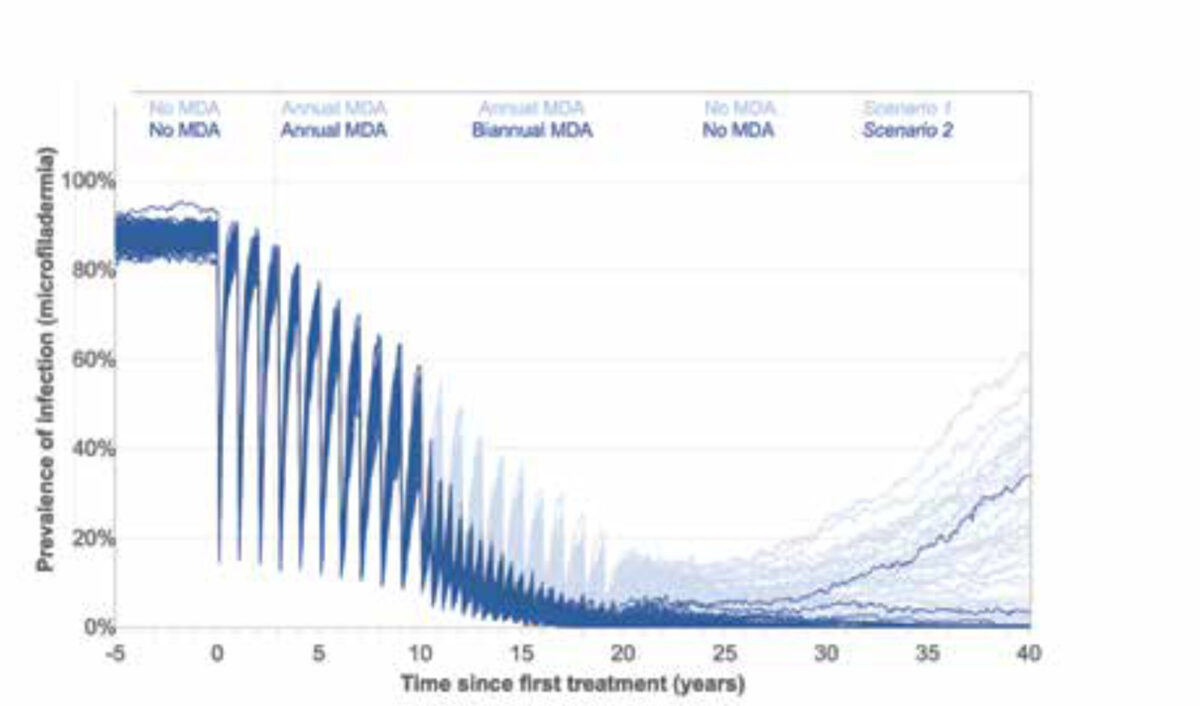Main content
Background
Helminths, parasitic worms, are a common cause of disease in tropical and subtropical regions worldwide, disproportionately affecting people living under poor conditions (lack of safe water, poor sanitation, substandard housing). Major helminthic diseases in humans include soil-transmitted helminthiases (STH: ascariasis, trichuriasis, hookworm), schistosomiasis (or bilharzia), lymphatic filariasis (LF), and onchocerciasis (or river blindness). They are characterized by the chronic nature of infection and slow development of severe, debilitating consequences such as visual impairment, skin changes, limb and genital deformities, growth retardation, and limited cognitive functioning. The clinical manifestations are often associated with stigma, reduced ability to learn, or reduced worker productivity, ultimately causing impoverishment. [1] The huge health and socio-economic impact of helminthic infections had for long been underestimated, resulting in insufficient attention in public health policy, research, and drug development. These diseases are therefore commonly referred to as neglected tropical diseases (NTDs).
Fortunately, international commitment to fight helminthic diseases has increased markedly over the last decades. The first major public health initiative was the Onchocerciasis Control Programme (OCP) in West Africa, which was set up in 1974 to fight onchocerciasis in eleven countries through vector control. A decade later, mass drug administration (MDA) of the new drug ivermectin was introduced as a new complementary or stand-alone strategy, following the demonstration of its safety and effectiveness and Merck’s pledge in 1987 to donate the drug “for as long as needed for the treatment and control of onchocerciasis”.
New large-scale programmes were set up in the 1990s, expanding ivermectin MDA into other endemic regions (African Programme for Onchocerciasis Control; Onchocerciasis Control Programme for the Americas). MDA also became the mainstay of control for filariasis and more recently – for schistosomiasis and STH. Indeed, MDA programmes have expanded at an unprecedented pace thanks to the enormous effort of affected countries [2] and spurred by the World Health Organization’s (WHO) roadmap on NTDs 2012-2020 [3] as well as medicine donations by several pharmaceutical companies. [4] Much has been achieved. In 2018, over one billion people received preventive chemotherapy for at least one of the four main helminthic diseases: 552 million people were treated for LF, 149 million for onchocerciasis, 572 million school-aged children were treated for STH, and 94 million school-aged children were treated for schistosomiasis. [2] In some countries or subnational areas, MDA is no longer required as elimination targets have been met.
Ambitious goals for 2030
There is great policy momentum to continue the fight against helminths as well as other NTDs, and global aspirations are high, as evidenced by Sustainable Development Goal (SDG) 3.3: to end the epidemic of neglected tropical diseases by 2030. Later this year, the WHO will present its new roadmap on NTDs for the period 2021-2030, with new disease-specific targets for 2030 aligned with SDG 3.3. Helminthic diseases are targeted for elimination as a public health problem (LF, schistosomiasis, STH) or elimination of transmission (onchocerciasis), defined as follows: [5]
Elimination (interruption of transmission): Reduction to zero of the incidence of infection caused by a specific pathogen in a defined geographical area, with minimal risk of reintroduction, as a result of deliberate efforts; continued action to prevent re-establishment of transmission may be required. Documentation of elimination of transmission is called verification. Elimination as a public health problem: A term related to both infection and disease, defined by achievement of measurable targets set by WHO in relation to a specific disease. When reached, continued action is required to maintain the targets and/ or to advance interruption of transmission. Documentation of elimination as a public health problem is called validation.
The question is to what extent the set targets can be achieved and which strategies are most effective to this end. Mathematical modelling is increasingly being accepted as an important source of evidence to answer this question.
Mathematical modelling of helminthic diseases
Mathematical models for infectious diseases describe key processes involved in transmission, disease development, and control measures in mathematical terms. They can be used to elucidate mechanisms of transmission, predict future trends in infection, and assess the likely impact (and costs) of interventions. The application of mathematical models to policy question on helminths has slowly increased over the past decades. [6] It was further boosted in 2014 by the formation of the Bill & Melinda Gates Foundation funded NTD Modelling Consortium, which aims to support ongoing efforts to control and eliminate NTDs by modelling and improving model quality by stimulating collaboration between different modelling groups. [7] Erasmus MC is a pioneer in NTD modelling. It started modelling onchocerciasis control before 1990, expanded its activities since then to include five other NTDs, and is the largest partner in the NTD Modelling Consortium.
Insights from modelling on reaching the 2030 targets
Several modellers, clustered around the NTD Modelling Consortium, have recently published a collection of open research letters summarizing lessons learned from modelling regarding the impact of interventions, the feasibility of proposed WHO 2030 targets, and possible strategy adjustments that can help to maximize the gains in the coming years. [8] Below we briefly describe the main findings for the four helminthic infections.
LF is targeted for ‘elimination as a public health problem’, which is said to be achieved if 1) transmission assessment surveys show that infection is sustained below a predefined threshold for at least four years after stopping MDA, and 2) an essential package of care is available for all patients suffering from filarial hydrocele (enlarged scrotum) or lymphoedema (swollen limbs or external genitalia). Twenty-four countries have already stopped MDA and are now under post-MDA or even post-validation surveillance. [9]
Modelling suggests that achieving the epidemiological target is feasible with MDA, but the required MDA duration depends on baseline endemicity. [10] Also, poor coverage and systematic non-adherence can severely impede elimination programmes, and programmes need to ensure good coverage to be successful. [10] Late starting programmes and programmes in high-endemicity settings could consider increasing the frequency of MDA (e.g. from yearly to 6-monthly) or switching to more effective treatment regimens. Low-level transmission can continue after stopping MDA and even after validating elimination as a public health problem, which entails a risk of resurgence. Vector control could mitigate this risk but is sometimes very difficult to implement, depending on the vector species.
Onchocerciasis is targeted for elimination of transmission using MDA of ivermectin. The WHO has formulated guidelines for stopping MDA and verifying elimination. Four countries in the Americas have already achieved country-wide elimination of onchocerciasis transmission, and a few others have stopped MDA in certain areas. [9] Due to the biology of the parasite and the limited effect of ivermectin (it kills the microfilariae offspring, not the adult worms), the timeline to elimination is long, easily spanning 15-20 years, and model results are uncertain about the feasibility of elimination in high-endemic settings. [11] Most of the 34 endemic countries will likely not achieve country-wide elimination by 2030.
To maximize the success probability and reduce the timeline to elimination, countries should consider acceleration strategies, e.g. increasing the frequency of mass treatment from annual to biannual (i.e. 6-monthly, see Figure 1), or complementing MDA by vector control where most needed and feasible. [11] Using more efficacious drugs (e.g. moxidectin) could also be an option if donated or made available at low cost. Furthermore, alternative strategies are required in Loa loa co-endemic areas, where the use of ivermectin is not safe due to a risk of very serious (sometimes lethal) side effects in people with heavy L. loa infections. Further research is needed on the risk and dynamics of resurgence after verification of elimination.
STH is targeted for elimination as a public health problem by reducing the prevalence of medium-to-high intensity infections through chemotherapy targeted at high-risk groups (initially only school-aged children 5-12 year old, but in the latest WHO guidelines also preschool-age children and women of reproductive age) with treatment frequency dependent on the baseline endemicity. Models confirm that infection targets can be met if the latest guidelines are followed, and that the inclusion of women of reproductive age (or even better, all adults) and biannual treatment of risk groups are needed in highly endemic areas. [12] Yet, how this translates to actual morbidity levels is not entirely certain. Models have clearly shown that resurgence will soon occur if treatment programs are stopped unless water, sanitation, and hygiene conditions are improved in compensation. Where hookworm is the dominant prevailing STH species, community-wide MDA may be recommended.
Schistosomiasis is targeted for elimination as a public health problem. Based on current WHO treatment guidelines, chemotherapy is targeted at school-aged children and given once every 1-3 years depending on baseline endemicity. Model analyses show that the current guidelines are sufficient for achieving the goal in areas with low and moderate intestinal schistosomiasis, but the impact on morbidity may very well be less than desired in settings with higher baseline endemicity levels (≥50% infection in school-age children). In such areas, treatment has to be expanded to adults. [13] Achieving elimination as a public health problem does not necessarily imply interruption of transmission, and chemotherapy will likely have to be continued to prevent resurgence and maintain the achievements.

Implications for the coming decade
The ambitious SDG goal 3.3 challenges the NTD community not only to maximize the health impact of NTD interventions in the next decade, but also to ensure sustainability of the achievements. Enhanced country ownership and integration of treatment and surveillance into the broader health systems are key to maintaining interventions and health gains. [14] Ultimately though, we need to target the underlying factors that drive helminth transmission, by implementing integrated vector management, improving access to safe water, sanitation and hygiene, and – above all – tackling poverty. [15]
References
- Hotez, Fenwick A, Savioli L, et al. Rescuing the bottom billion through control of neglected tropical diseases. Lancet. 2009 May 2;373(9674):1570-5.
- World Health Organization. Global update on implementation of preventive chemotherapy against neglected tropical diseases in 2018. Weekly Epidemiological Record. 2019;94(38):425-38.
- World Health Organization. Accelerating work to overcome the global impact of neglected tropical diseases: a roadmap for implementation: executive summary. Geneva: World Health Organization; 2012. 22 p. Available from: https://apps.who.int/iris/handle/10665/70809.
- World Health Organization. Essential medicines donated to control, eliminate and eradicate neglected tropical diseases. Geneva: World Health Organization; 2019 [cited 2020 February 7]. 3 p. Available from: https://www.who.int/neglected_diseases/Medicine-donation-04-march-2019.pdf.
- World Health Organization. Generic framework for control, elimination and eradication of neglected tropical diseases. Geneva: World Health Organization; 2016 [cited 2020 Mar 13]. 6 p. Available from: https://apps.who.int/iris/handle/10665/205080.
- Basáñez MG, McCarthy JS, et al. A research agenda for helminth diseases of humans: modelling for control and elimination. PLoS Negl Trop Dis. 2012 Apr;6(4). DOI:10.1371/journal.pntd.0001548.
- Hollingsworth TD, Adams ER, Anderson RM, et al. Quantitative analyses and modelling to support achievement of the 2020 goals for nine neglected tropical diseases. Parasit Vectors. 2015 Dec; 8:630. DOI:10.1186/813071-015-1235-1.
- Gates Open Research. 2030 goals for neglected tropical diseases. Open letters NTD Modelling Consortium. 2019 Sep 13-2020 Mar 4 [cited 2020 Feb 7]. Available from: https://gatesopenresearch.org/collections/ntd.
- Uniting to Combat Neglected Tropical Diseases. Impact dashboard for preventive chemotherapy (PC) diseases. Cited 2020 Feb 7. Available from: https://unitingtocombatntds.org/impact-dashboards/pc-diseases-dashboard/.
- Stolk WA, Prada JM, Smith ME, et al. Are alternative strategies required to accelerate the global elimination of lymphatic filariasis?: insights from mathematical models. Clin Infect Dis. 2018 Jun 1;66(suppl_4): $260-S266.
- Verver S, Walker M, Kim YE, et al. How can onchocerciasis elimination in Africa be accelerated?: modeling the impact of Increased ivermectin treatment frequency and complementary vector control. Clin Infect Dis. 2018 Jun 1;66(suppl_4):S267-S274.
- Farrell SH, Coffeng LE, Truscott JE, et al. Investigating the effectiveness of current and modified World Health Organization guidelines for the control of soil-transmitted helminth infections. Clin Infect Dis. 2018 Jun 1;66(suppl_4):S253-S259.
- Toor J, Alsallaq R, Truscott JE, et al. Are we on our way to achieving the 2020 goals for schistosomiasis morbidity control using current World Health Organization guidelines? Clin Infect Dis. 2018 Jun 1;66(suppl_4):S245-S252.
- Malecela MN. Reflections on the decade of the neglected tropical diseases. Int Health. 2019 Sep;11(5):338-40. DOI:10.1093/inthealth/ihz048.
- Engels D, Zhou X. Neglected tropical diseases: an effective global response to local poverty-related disease priorities. Infect Dis Poverty. 2020 Jan;9(1):10. DOI:10.1186/540249-020-0630-9.


















































